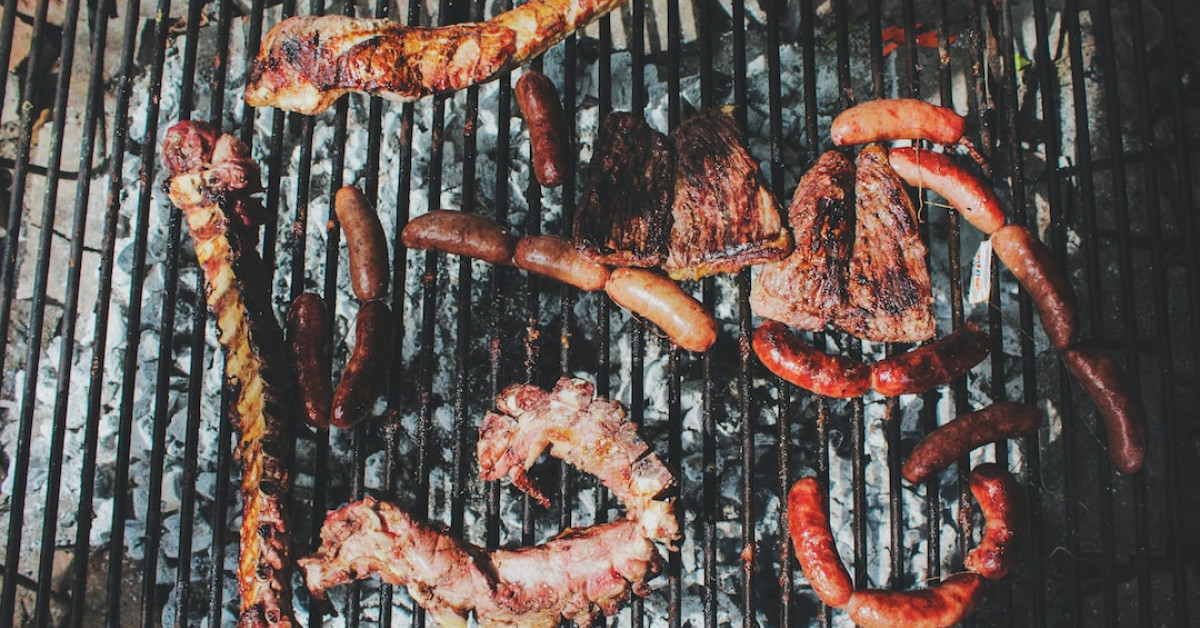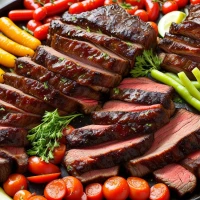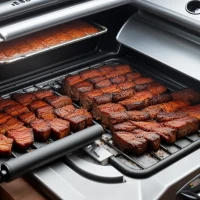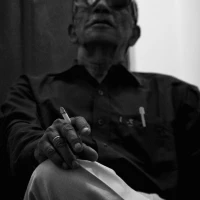Grilling a brisket to perfection is a culinary achievement that many aspire to conquer. While traditionally smoked over wood, grilling brisket on a gas grill presents a unique set of challenges and opportunities. This article will guide you step-by-step on how to grill a brisket that’s juicy, tender, and flavor-packed, even without the smokehouse setup. Understand the nuances of managing temperature, timing, and technique on your gas grill, and leave your guests guessing the secret of your grilling mastery. So, grab your apron, and let’s uncover the world of brisket on gas grills.
The Secret to a Perfect Brisket, Revealed!
When diving into the world of grilling, especially grilling a robust piece of meat like brisket on a gas grill, knowing a few key points can make a world of difference. Let’s break down those top secrets:
Choosing Your Brisket
Selecting the right brisket is the first step towards grilling success. A brisket is comprised of two parts: the flat and the point. The flat is leaner while the point is more marbled with fat. Here’s what to look for:
- Grade of the Meat: Opt for choice or prime grades for the best marbling.
- Uniform Thickness: Ensures even cooking.
- Flexibility: A good brisket will bend easily in the package, indicating tenderness.
Prepping the Meat for The Grill
When you’ve chosen your brisket, preparation is vital. Follow these steps:
- Trimming: Trim the fat cap to about a quarter-inch thickness.
- Seasoning: Use a simple rub or a more complex blend to suit your taste.
- Resting: Allow the seasoned brisket to rest and absorb the flavors.
The Gas Grill Advantage
Grilling brisket on a gas grill has its perks:
- Temperature Control: Gas grills provide a consistent cooking temperature.
- Convenience: It’s easier to maintain and clean than traditional smokers.
- Versatility: You can create different heat zones for indirect cooking, which is key for brisket.
Grilling Brisket on Gas Grill: Step by Step
Setting Up Your Grill
Before you introduce meat to flame, proper setup of your gas grill is essential:
- Preheat the Grill: Aim for a temperature around 225°F for low and slow cooking.
- Create Heat Zones: Use a two-zone setup for indirect grilling.
- Add Smoker Box (optional): Enhance the flavor with a smoker box filled with wood chips.
Managing the Cook
It’s all about the low and slow approach when cooking a brisket:
- Monitor the Temperature: Keep the grill temperature constant.
- Use a Meat Thermometer: Track the brisket’s internal temperature.
- Be Patient: Expect the cooking process to take several hours.
Finishing Your Brisket
After a long, slow cook, your brisket is nearly ready:
- The Stall: The internal meat temperature halts around 150-160°F; don’t panic—this is normal!
- Wrap if Desired: A foil or butcher paper wrap can push through the stall.
- Final Temperature Goal: Aim for an internal temperature of about 200°F for tenderness.
- Resting: Let the brisket rest post-cook, tented in foil, for juices to redistribute.
Carving and Serving: The Final Act
The moment of truth comes when it’s time to slice into that brisket. Ensure you:
- Slice against the grain: Slicing against the muscle fibres ensures tenderness.
- Choose the Right Knife: A long, sharp knife will produce clean cuts.
- Serve in Style: Pair your brisket with sides that complement its rich flavor.
Now that we’ve established a roadmap, let’s delve into the brass tacks of grilling a tantalizing brisket on your gas grill.
Preparing the Ultimate Brisket
A brisket’s journey from the butcher block to the dinner plate begins well before it hits the grill. Proper preparation sets the stage for the flavors and textures to develop during cooking.
Trimming and Seasoning: The Foundation of Flavor
Selecting and Trimming the Brisket:
The cut of your brisket can influence the end result almost as much as the grilling method itself. Look for one with:
- Good Marbling: This fat within the meat leads to mouthwatering fullness of flavor.
- Bright Color: Freshness is key with brisket, as with any meat choice.
- Proper Trim: Leave about ¼-inch of fat for moisture and flavor.
Building Your Flavor Profile:
Spices and herbs play an essential role in brisket preparation. When creating your rub, consider balancing:
- Salt and Pepper: They are the cornerstones of a traditional Texas-style brisket.
- Paprika and Garlic Powder: For a bit of smokiness and savoriness.
- Brown Sugar: Adds sweetness and helps form a crust, known as bark.
- Unique Additions: Consider cumin, onion powder, or even coffee grounds for a twist.
The Marinating Moment
For some, marinating the brisket before it hits the heat is a sacred step:
- Injection: You can inject your brisket with beef stock or marinade for extra moisture.
- Dry Brine: Salt the brisket and let it sit overnight to enhance flavor deeply.
The Grilling Beginnings: Starting Strong
Firing Up Your Gas Grill
To set the stage, you’ll need to understand your equipment. Here’s how to get started:
Creating a Heat Zone:
- The two-zone setup: One side of your grill should be set to a low temperature while the other side remains off.
- Consistent Temperature: Aim to maintain a steady 225-250°F throughout the cooking process.
Adding Smoke to a Gas Grill:
If you seek that authentic smoky brisket flavor, consider using:
- Wood Chips: Hickory, mesquite, or fruitwoods like apple or cherry can infuse your brisket with delectable smoke notes.
- Smoker Box: This simple accessory can turn your gas grill into a makeshift smoker.
Beginning the Brisket Journey
The Initial Placement:
Place your brisket fat side up on the cool side of the grill, away from direct heat, enabling the fat to render slowly and naturally baste the meat.
Monitoring Progress:
- Checking regularly: Use both the built-in grill thermometer and a digital meat thermometer to monitor grill and meat temperature.
- Adjusting the heat: Fine-tune your burner settings to maintain a consistent temperature.
Navigating the Long Cook
The Brisket Stall: A Long Cook’s Hurdle
Grilling brisket is a marathon, not a sprint, and knowing how to manage “the stall” is crucial:
- Understanding the Stall: A phenomenon where the brisket’s internal temperature plateaus.
- Using the Texas Crutch: Wrapping the brisket in aluminum foil can help push past the stall more quickly.
Battling the Elements
Even on a gas grill, external factors like temperature and weather can affect your cook:
- Wind and Temperature Variations: Have a grill blanket or windbreak ready for unforeseen weather changes.
- Fuel Levels: Keep an extra propane tank handy to ensure you don’t run out mid-cook.
The Process of Perfection: Bringing Brisket to Completion
Assessing Doneness
Grilling brisket is both a science and an art, and achieving the perfect finish requires a bit of both:
- Probing for Tenderness: Your brisket is done when the meat feels like “butter” as you probe.
- Resting the Meat: Wrapping and resting the brisket allows the juices to redistribute.
Resting and Slicing Brisket
The journey culminates when you’re ready to serve:
- Resting Time: Let your brisket rest for at least one hour, though some enthusiasts argue for even longer.
- The Art of Slicing: Find the grain of the meat and slice perpendicular to it for ultimate tenderness.
Serving Your Masterpiece
Presentation and Pairing
A true brisket experience doesn’t end with the meat; it’s everything that comes with it:
- Serving Ware: Choose platters that enhance the brisket’s visual appeal.
- Sides That Shine: Prepare sides like coleslaw, baked beans, and cornbread to complement the main dish.
Sharing the Secret to Your Success
After you’ve enjoyed the fruits of your labor, don’t be surprised if your friends and family want to know your secret. Share your newfound wisdom, or keep a few tricks up your sleeve for the next backyard BBQ challenge.
Final Thoughts on Grilling Brisket on a Gas Grill
Grilling a brisket on a gas grill is a rewarding, if demanding, culinary endeavor. By balancing time, temperature, and technique, it’s possible to achieve results that rival the pitmasters. With your gas grill and a bit of patience, you can transform a humble cut of beef into the centerpiece of a memorable meal. Whether you’re a seasoned griller or a weekend cookout enthusiast, your brisket journey starts here. Fire up that grill, embrace the process, and prepare to astound with your grilled brisket expertise.










